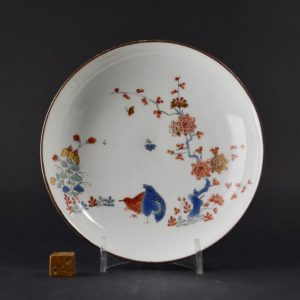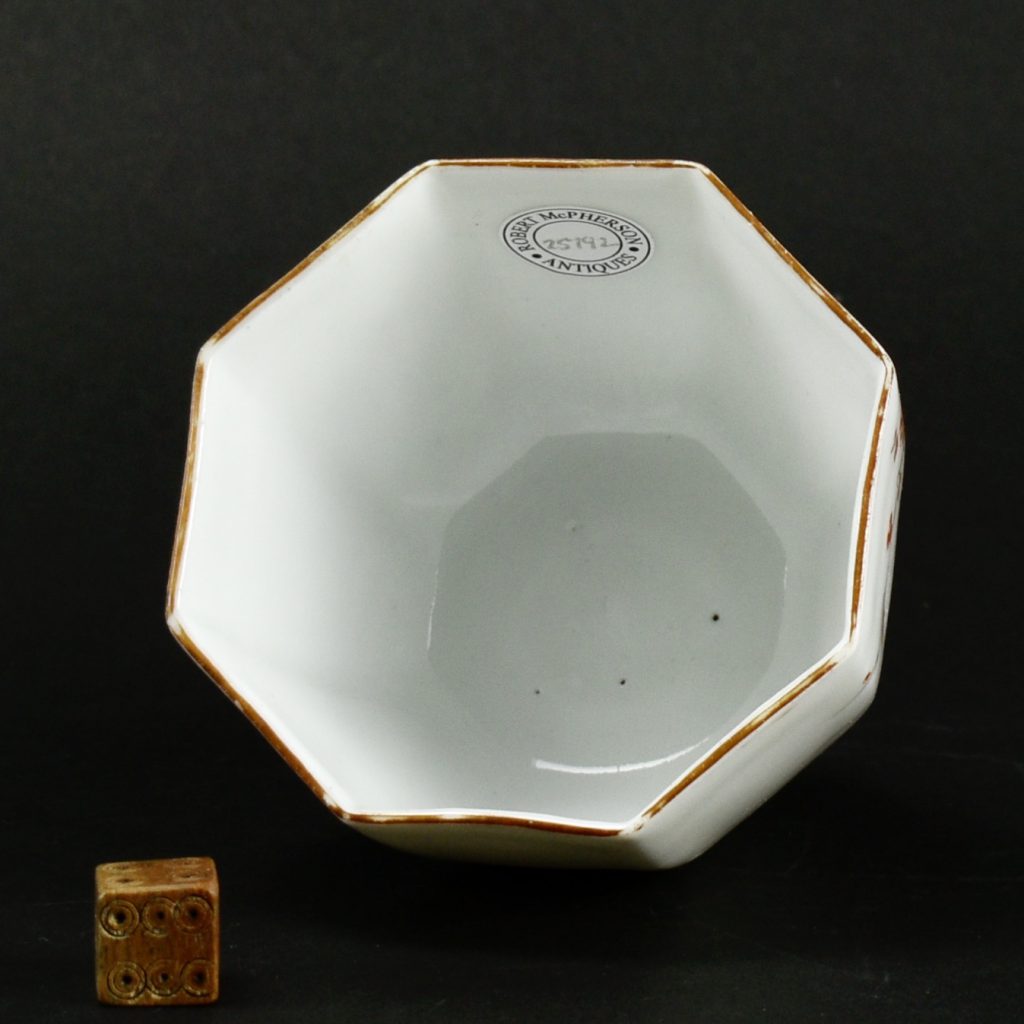
An 18th Century Meissen Porcelain Kakiemon Style Beaker
An 18th Century Meissen Porcelain Octagonal Beaker, decorated in the Kakiemon style c.1735-1745. From the collection of Soame Jenyns, Deputy Keeper of Asian Antiquities, British Museum (1950-1968). Painted with a version of the ‘Two Quail’ design with a prunus tree and other flowers as well as insects. This Meissen porcelain beaker is quite close to the Japanese kakiemon porcelain original in terms of painting style as well as the enamel colours employed. The base of this beaker has had the Meissen blue crossed-sword mark carefully ground out. It is likely this was done in the 18th century as the Japanese originals would have been more sought after. Soame Jenyns would have been interested in this deception as it is part of the story of Kakiemon porcelain and its interaction with the West.
SOLD
- Condition
- In good condition, some wear to the extremities of the brown rim, a few scratchees to one side. The Meissen crossed-swords mark has been erased, next to that is a tiny glaze crack, presumably as a result of the grinding.
- Size
- Diameter 8.2 cm (3 1/8 inches) Height 6 cm (2 1/3 inches)
- Provenance
- Soame Jenyns, Deputy Keeper of Asian Antiquities, British Museum (1950-1968) and thence by decent. Mr. Roger Soame Jenyns (1904-1976) was the foremost scholar of his generation in the arts of Japan and China. He was a discerning collector and a member of the British General Committee of the Royal Academy Exhibition 1935-1956. His books include Later Chinese Ceramics (1951) Ming Pottery and Porcelain (1953) Wares of the Transitional Period between Ming and the Ch'ing 1620-1683 (1955) Japanese Porcelain (1965) Japanese Pottery (1971) and (with Margaret Jourdain) Chinese Export Art in the Eighteenth Century (1950). For more information see : Provenance ; Collectors, Dealers & Scholars : Chinese Ceramics in Britain & America (Roy Davids, Dominic Jellinek, Privately Printed, 2011. ISBN 978-0-9570148-0-0).
- Stock number
- 25792
Information
A Related Meissen Saucer in the Kakiemon Style c.1735 - 1745
Provenace : R and G McPherson Antuiques, The John Drew Collection, Robert McPherson Antiques (sold).




Meissen Porcelain :
Meissen porcelain was the first hard-paste porcelain, or true porcelain to be developed in Europe. Development of this new hard-paste porcelain by Ehrenfried Walther von Tschirnhaus started in 1707. When Tschirnhaus suddenly died, the recipe apparently was handed over to Böttger, who within one week announced to the Elector that he could make porcelain. Böttger refined the formula and with some Dutch co-workers, experienced in firing and painting tiles, the stage was set for the manufacturing of porcelain. In 1709, the Elector established the first Meissen porcelain factory, placed Böttger`s laboratory at Albrechtsburg castle in Meissen and production started officially in 1710. In 1720 Johann Gregorius Höroldt became the director and introduced brilliant colours which made Meissen porcelain famous. The next sculptor, Johann Jakob Kirchner, was the first to make large-scale statues and figurines, especially of Baroque saints. His assistant was Johann Joachim Kaendler; in 1733 Kirchner resigned, and Kaendler took over as chief “modelmaster”. He became the most famous of the Meissen sculptors. Under his direction Meissen produced the series of small figurines, often depicting scenes of gallantry, which brought out the best of the new material. His menagerie of large-scale animals, left in the white, are some of the high points of European porcelain manufacture. His work resulted in the production of exquisite figurines in the rococo style that influenced porcelain making in all of Europe. Supported by assistants like Johann Friedrich Eberlein and Peter Reinecke, he worked until his death in 1775. In 1756, during the Seven Years` War, Prussian troops occupied Meissen, giving Frederick II of Prussia the opportunity to relocate some of the artisans to establish the Königliche Porzellan Manufaktur Berlin. With the changing tastes of the neoclassical period and the rise of Sèvres porcelain in the 1760s, Meissen had to readjust its production, and in the reorganization from 1763, C.W.E. Dietrich of the Dresden Academy became artistic director and Michel-Victor Acier from France became the modelmaster. The practice of impressing numerals that correspond to moulds in the inventory books began in 1763. Sèvres styles and ventures into Neoclassicism, such as matte bisque wares that had the effect of white marble, marked the factory`s output under Count Camillo Marcolini, from 1774.
Kakiemon Porcelain :
Kakiemon decoration is usually of high quality, often delicate and with well-balanced asymmetric designs. The designs were normally quite sparse emphasizing the fine white porcelain body known in Japan as Nigoshide (milky white). The opaque white milky Nigoshide body was used on the finest pieces, it appears that it was reserved for fine quality enamelled decoration. Kakiemon porcelain was decorated with a great variety of imaginative designs which include elements such as the `banded hedge`, `flying squirrel`, and the `Quail and Millet` design. The `Three Friends of Winter` were also a very popular group of designs, other subject taken from nature include flowers (especially the chrysanthemum, the national flower of Japan) as well as birds and rock-work. Figural subjects such as the `Hob in the Well` were also popular. This design illustrates a Chinese folk tale where a sage saves his friend who has fallen into a large fish-bowl by throwing stones at it, braking open the pot. Banded-Hedges were a formal device within Japanese traditional gardens, they were often incorporated in designs, includes `The Three Friends of Winter` (Pine, Bamboo and Prunus). These three plants signify perseverance, as neither the pine nor the bamboo shed their leaves in winter and the plumb (Prunus) flowers at the very end of the winter, heralding the arrival of spring.




